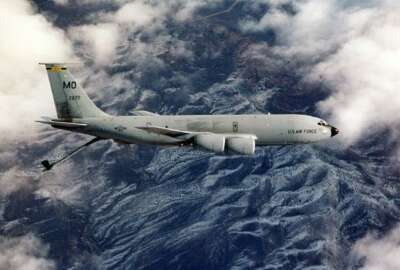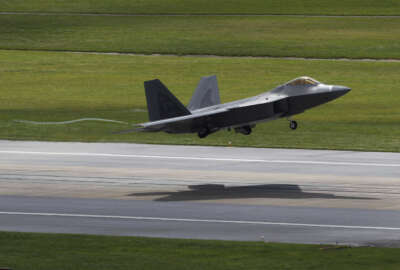
Is the Air Force abandoning its close air support mission?
The Air Force has long had the job of providing close air support for Army and Marine Corps ground troops. Its what made the A-10 attack fighter such a beloved...
The Air Force has long had the job of providing close air support for Army and Marine Corps ground troops. Its what made the A-10 attack fighter such a beloved instrument. The F-35 is supposed to replace the A-10 in that role. But internal Air Force documents suggest the Air Force will no longer provide close air support. The Federal Drive with Tom Temin learned more from the Project on Government Oversight’s Dan Grazier.
Interview transcript:
Dan Grazier
This is a really important story: Close air support in the attack role, it’s one of the most valuable combat roles military aviation has. An invaluable part of ground warfare. It’s very difficult for us to fight wars today without adequate air support. And so it’s really disappointing to see that the Air Force one, counts the close air support mission as largely secondary. And two, that they are not devoting any training resources for close air support for the big marquee fighter plane, that they’ve been developing now for more than 20 years.Tom Temin
How did you find this all out?Dan Grazier
I had a source approached me with this story. It’s just based on a lot of the reporting that I’ve done over the years, about the A-10, about the closer support capability in the U.S. military. And so when it was noticed that the Air Force had ignored the close air support mission for the F-35 program, I had a brave source that came forward to make sure the public knew what was going on.Tom Temin
Right. So their documents of the Air Force, in which the mention of close air support of the ground, are simply omitted?Dan Grazier
Correct. What I have is, well it’s a couple of documents, but the main one is the F-35A ready aircrew training memorandum. So it outlines all the training requirements from headquarters air force that’s given to the operational group commanders. It dictates how many sorties are supposed to be devoted to particular missions. And for the F-35 memo, it covers 2023 and 2024. And in that, it’s kind of broken down by pilot’s experience level, by the role in the squadrons, and by the component, whether they’re in the active duty reserves or National Guard. It shows, for each of those categories, how many training sorties they’re supposed to fly for particular missions. And just for one example, an inexperienced combat mission-ready pilot, so one of the gun fighter pilots in his squadron, his primary role is just to fly aircraft. An active duty inexperienced kind of mission-ready pilot, is supposed to fly 216 training sorties across 2023 and 2024. And not a single one of those is a close air support requirement. And there are, when you looked at the documents, you will see that there are no close air support training requirements for any pilot of any experience level in any of the components of the Air Force.Tom Temin
And close air support is a difficult mission, isn’t it?Dan Grazier
Right. It’s a really delicate mission. My prior experience as a tank officer in the Marine Corps, where I lived and breathed combined arms, we did a lot of training with artillery and aviation. And so I’ve had plenty of times when I’ve been on the ground and aircraft have drop ordnance pretty close to my position. And want to make sure that when you’re given that “cleared hot” for weapons release that that pilot has plenty of experience in this mission. It’s not something that can just be done on the fly. That’s something that you have to train to do. So it’s really disappointing to see that the Air Force has largely ignored close air support now.Tom Temin
And what exactly do they say the F-35 is for, I’ve kind of lost track over all these years, because they don’t expect it to be in dog fights like in World War II. But they do expect it to suppress enemy airpower in some manner?Dan Grazier
Right, for the F-35A, the Air Force’s variant, it was sold as a direct replacement for the F-16, which largely has the air superiority role. And the A-10, which has the attack role and the close air support role, kind of rolled into that. You could go all the way back, I even pulled for this latest report, I pulled the original CNN story from October of 2001, when Lockheed Martin won the contract to develop the Joint Strike Fighter. And right therein, it says that this new aircraft was supposed to be a replacement for the A-10. And then a couple years ago, there was a hearing, kind of contentious hearing in the Senate Armed Services Committee, where there was some discussion that the F-35 wasn’t really going to do the A-10 mission. But Dr. Michael Gilmore, who was then the Pentagon’s testing director, he pulled out the operational requirements documents for the F-35 program, and it said right there, that it was an A-10 replacement. So close air support is supposed to be a part of the F-35 program. And the documents show that the Air Force has not taken it very seriously.Tom Temin
We’re speaking with Dan Grazier, He is senior military fellow at the Project on Government Oversight. Now the A-10 had a, effective, from what I’ve read but somewhat basic, type of methodology for providing ground air support. And that was simply a great big gun sticking out the front end of it. And this thing had lots of ammunition, a big box of bullets in this thing and it would fire. I think the pilot actually pushes the button to make it fire big caliber bullets shooting out the front of it. Does the F-35 even have that capability, is there a gun in its nose?Dan Grazier
Well, the F-35 doesn’t have a gun in its nose, it’s kind of on the shoulder of the aircraft. But it has a much lower ammunition capacity. The A-10 can fire, I forget the exact number, but it’s well over 1,000. I think it’s around 1,200, 30 millimeter rounds out of the big Gatling gun, out of the nose. And the F-35A, has a shoulder mounted, I think it’s a 25 millimeter cannon, but it only holds 181 rounds. So that’s one pass, firing the cannon. But the canon on the F-35A doesn’t even work properly. So that’s been a part of the testing reports for years now, is that the the gun on the F-35A is inaccurate. So if I was still on the ground, and somebody told me that an F-35A was going to make a gun pass, across my position, I wouldn’t feel very comfortable with that. I would feel much more comfortable with a highly accurate A-10 flown by a pilot who specializes in that mission.Tom Temin
Well, just moving this up a level, is there some doctrinal change at the Air Combat Operations Center that says this is something we’re not going to do? Is Congress required to decide whether the Air Force can simply abandon apparently a mission that it’s had for many years?Dan Grazier
Well, so this is much more of an executive thing. So going all the way back through history now, the Air Force became independent in the fall of 1947. And then in the early spring of 1948, the first Secretary of Defense gathered all the service chiefs down in Key West, to iron out specifics about roles and missions, about which service is going to handle what mission. And so going all the way back to early 1948, it was decided that the Air Force was going to provide that close combat support for the Army. That agreement was signed by President Truman. So this is an executive order going all the way back to 1948, that the Air Force is supposed to provide close air support. There’s been no big doctrinal change, since then, that’s always been always been a part of it. So this is just an internal decision that the Air Force made. And it’s unclear if anybody gave them authorization for that. I put in questions to the Air Force; I got kind of a watered down response from them. I’ve put in a request to the Army and the Office of Secretary of Defense just to get their take on this development. And I haven’t heard anything back from the Army or the Secretary of Defense about it. So it’s unclear if anybody gave Air Force leaders permission to make this change.Tom Temin
Interesting. Well, if it gets out now — and now it will be getting out — we’ll see what happens. I imagine probably the Hill might respond.Dan Grazier
Well, I would hope so. The Hill will definitely be made aware of this, because I spend plenty of time talking to staffers on Capitol Hill, bringing their attention to matters like this. And I can assure you that this is something that we’re going to be talking about a lot with people on Capitol Hill. Particularly, as the Air Force is widely expected to approach Congress for the next National Defense Authorization cycle, seeking permission to retire the rest of the A-10 fleet. So this is a hugely important development to that. And really, this F-35 training memo really shows the value of the A-10. The importance of having a dedicated attack program that is really unsuited for a lot of other roles, like it’s created this cadre of closer support specialists. And then if the A-10 program goes away, that’s going to vanish very quickly. And as this memo shows, the Air Force is not going. It doesn’t appear really willing to devote a lot of training resources for their multirole aircraft, just trained to this mission.
Copyright © 2025 Federal News Network. All rights reserved. This website is not intended for users located within the European Economic Area.
Tom Temin is host of the Federal Drive and has been providing insight on federal technology and management issues for more than 30 years.
Follow @tteminWFED





